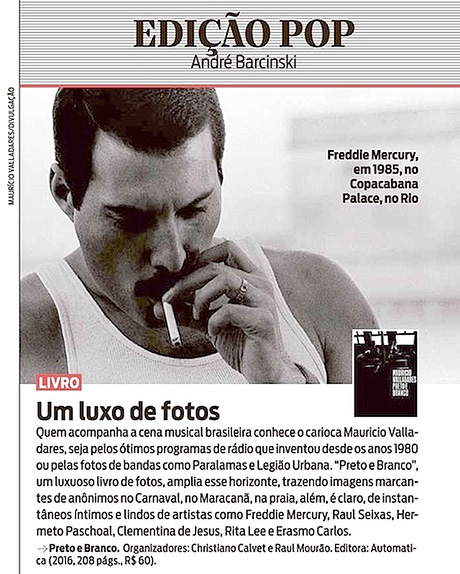



![]()
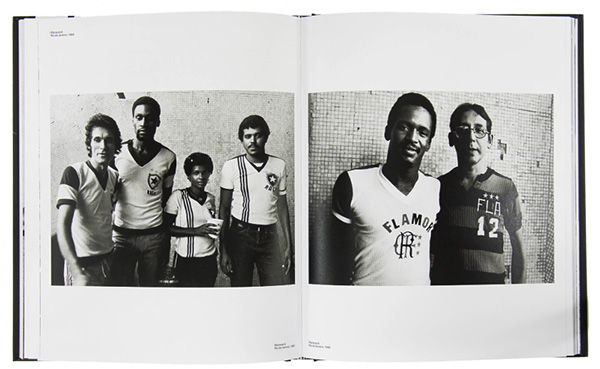

Arquivo da categoria: imprensa
the wire top 50 / 2016…

- David Bowie – Blackstar
- Shirley Collins – Lodestar
- Moor Mother – Fetish Bones
- Autechre – elseq 1-5
- Nick Cave & the Bad Seeds – Skeleton Tree
- Jenny Hval – Blood Bitch
- Noura Mint Seymali – Arbina
- Yves Tumor – Serpent Music
- Gaika – SECURITY
- Mark Ernestus’ Ndagga Rhythm Force – Yermande
- Gate – Saturday Night Fever
- Solange – A Seat at the Table
- Kanye West – The Life of Pablo
- Oren Ambarchi – Hubris
- Babyfather – “BBF” Hosted By DJ Escrow
- 75 Dollar Bill – Wood / Metal / Plastic / Pattern / Rhythm / Rock
- Anna Meredith – Varmints
- Kaitlyn Aurelia Smith – EARS
- A Tribe Called Quest – We got it from Here… Thank You 4 Your service
- Carla dal Forno – You Know What It’s Like
- David Toop – Entities Inertias Faint Beings
- Leonard Cohen – You Want It Darker
- Kendrick Lamar – Untitled Unmastered
- Idris Ackamoor & The Pyramids – We Be All Africans
- Laura Cannell – Simultaneous Flight Movement
- Ectoplasm Girls – New Feeling Come
- Steve Gunn – Eyes on the Lines
- Ian William Craig – Centres
- Matmos – Ultimate Care II
- Laraaji & Sun Araw – Professional Sunflow
- Scott Walker – The Childhood of a Leader (OST)
- Bitchin Bajas & Bonnie “Prince” Billy – Epic Jammers and Fortunate Little Ditties
- Elysia Crampton – Elysia Crampton Presents: Demon City
- Katie Gately – Color
- Shackleton with Ernesto Tomasini – Devotional Songs
- Anxiety – Anxiety
- Skepta – Konnichiwa
- Puce Mary – The Spiral
- The Dwarfs of East Agouza – Bes
- Catherine Christer Hennix – Live At Issue Project Room
- Horse Lords – Interventions
- Roy Montgomery – R M H Q: Headquarters
- Frank Ocean – Blonde
- Thalia Zedek – Eve
- Charlemagne Palestine – Cathédrale De Strasbourg
- Kepler Quartet – Ben Johnston: String Quartets Nos. 6, 7, & 8
- Circuit Des Yeux – Jackie Lynn
- Zomby – Ultra
- Klara Lewis – Too
- Peder Mannerfelt – Controlling Body
“o planeta lamma é sete palmos debaixo do chão”…
aconteceu em 10maio e publicado em 12maio1993 pelo glorioso pedro só…


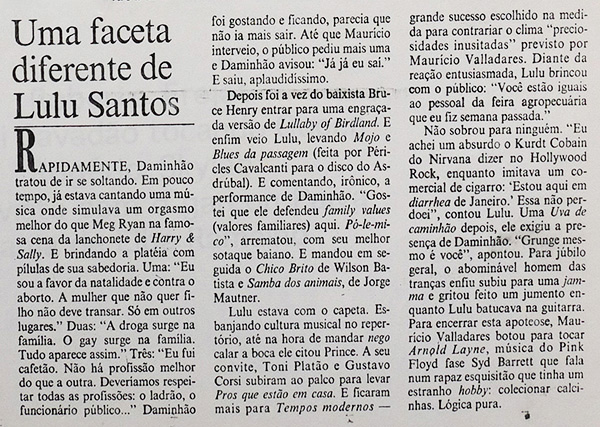
espírito indomável (ou stormbringer)…
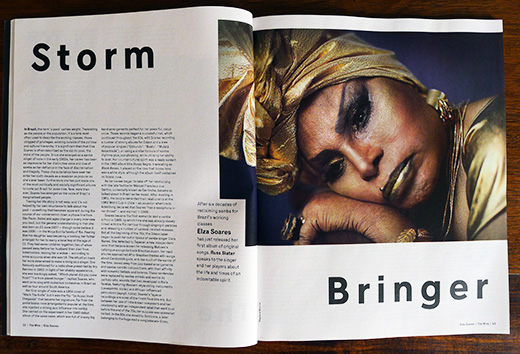


simples assim… Deusa!
skylab disse pra gente, em 2010…

A Lama na Música Brasileira
06/03/2010
Na música popular brasileira, dois artistas usaram a palavra “lama” com tanta insistência, que o referido termo acabou assumindo o papel de palavra chave em ambos os trabalhos. Quero me referir a Damião Experiença e Chico Science.
Ainda assim, o sentido do termo é completamente diferente em um e outro.
A lama em Chico tem um sentido preciso, localizável: os manguezais dos rios de Recife. João Cabral já se referia a essa lama em Morte e Vida Severina. Essa lama é a base do Mangue Beat: é denuncia, mas é também inserção:
“ A ciência conseguiu juntar
o mangue com o mundo
e de lá saiu
um malungo boy malungo
Antenado, camarada, malungo.
Sangue bom. Francisco de Assis. Malungo sempre bom.”
in, Malungo
Da Lama ao Caos, fala-se em Sandino e Lampião. E a revolução é o caminho a se trilhar, sem abrir mão da modernidade. Sair da miséria tem como corolário o computador e a modernidade. A lama é a miséria e a insurreição.
A música de Chico e seus respectivos arranjos apontam na direção dessa inserção ao mundo moderno. Cheia de overdrives e dub, lado a lado com os tambores do maracatu, o hibridismo já era sugerido no tropicalismo: Luiz Gonzaga e Beatles.
Não é de se admirar, portanto, que houvesse pronta aceitação, apesar da morte prematura de Chico. A nossa “Inteligenzia” adotou o Mangue Beat de braços abertos e Chico Science, ainda que com apenas dois discos, se tornou referência de nossa cultura.
O mesmo não se pode falar em relação a Damião Experiença. Caso limite, passou ao largo da nossa “Inteligenzia”. Nenhum disco seu, dos tantos que produziu (alguns chutam o número de 36), consta de alguma lista dos dez mais. É uma sombra na música popular brasileira, quando não é motivo de chacota. O programa Ronca Ronca, que me fez conhecê-lo, certa ocasião entrevistava o músico Frejat e este fez menção a uma gravação de Damião no estúdio de Torquato Mariano:
– o técnico de som estava preparando os equipamentos e quando informou a Damião que podia começar, este lhe disse que já havia terminado (risos).
Em Damião, seja por uma insuficiência técnica ou mental, o reguea não é reguea, a música é quase sempre a mesma, o seu violão de poucas cordas só faz barulho e a gaita não toca lá coisa com coisa. Daí, a primeira diferença em relação a Chico, que, quando ouvimos, distinguimos o maracatu, a embolada, a ciranda e outros ritmos pernambucanos. Em Chico existe a idéia de uma restauração agregada a novas tecnologias. Já em Damião não existe restauração nenhuma, é tudo impreciso, inacabado, precário, e daí, por mais paradoxal que seja, a sua força.
O mundo de Damião é tão subjetivo, que está longe de qualquer inserção ao mundo moderno. Em seu livro, que se repete em suas músicas, suas afirmações contra o aborto e contra a nova igreja (teologia da libertação) estão na contramão da história. Poderia-se mesmo, diante desse anacronismo, construir-se um mundo reacionário, anti-moderno, não fosse a sua linguagem de bas-fond, cheia de palavrões e sexo. Impossível um discurso lógico em sua fala, ao contrário do Mangue Beat. É aí que talvez pudéssemos aproximá-lo a Bispo do Rosário com sua técnica de assemblage e seu amor à taxonomia. Psicótico e também marinheiro, como havia sido Damião, Bispo retirava do lixo os seus materiais, o que dava a seu trabalho uma conformação ao tempo. Ambos foram contemporâneos. Se o discurso de Bispo esvaziava-se de uma lógica narrativa, uma vez que a idéia de coleção retira o privilégio de determinados materiais em relação a outros, o discurso de Damião também o fazia. “Todos são iguais, homem ou mulher, preto ou branco, todos são iguais”. E aí, creio, está a base de seu trabalho e o sentido que toma a palavra lama: “ Porque todos nós iremos para a lama. Porque depois que nós morremos, a gente vai para o chão, se a gente é queimado, depois as cinzas, a gente põe no chão e elas viram lama. Então eu digo: Planeta Lamma. É o planeta mais certo que existe no universo. Porque todos ali são iguais, um não pode falar do outro porque todos vão para ali, para serem eles mesmos, podem ser brancos, amarelos, pode ser encardido. Pode estar lindo, pode estar bem pintado, pode ter a maior mansão, tudo de confortável, de repente bateu o coração, e vamos todos nós para o Planeta Lamma” .
Não é à toa o nome “Damião Experiença”. A palavra “experiência” tem em Damião um status tal e qual a palavra “lama”. E se pensarmos bem, ambas se equivalem. Aliás, sua biografia está quase toda nas canções. Não nego que ao me remeter a “Jimmy Hendrix and Experience”, e mesmo “Fátima Bernardes Experiência”, fui levado inicialmente a pensar a “experiência” no sentido científico do termo: um laboratório de experiência, experimentações científicas como o skylab americano. A questão é que, dessa forma, pode-se mergulhar numa determinada prática, em detrimento a outras do senso comum,
e então instaurar-se um processo de hierarquização. Os movimentos vanguardistas do século passado caíram nessa armadilha e acabaram apenas invertendo o platonismo, o que os impediram de uma alternativa real à Metafísica.
Mergulhar no seio da experiência, desarticulando qualquer possibilidade de discurso, é aonde nos leva as canções de Damião, alguém de olhos e ouvidos bem abertos ao seu tempo. E lá vai a sucessão de suas imagens:
“o erro foi meu, casar com mulher furada, que outro comeu”; “a mulher que faz aborto não tem pena do seu próprio corpo… para evitar, deve tomar no ânu o ano inteiro”; “vamos deixar de lado a TV – máquina doida”; “a música é pátria do universo, não tem fronteira”; “planeta lamma – 27 palmo debaixo da terra, pode ser barões, ladrões”; “a droga é a história do universo, a língua das pessoas é mais suja do que as drogas”; “o mundo é minha pátria – eu abro a janela, uma aquarela”; “não gosto de ditadura, tem fingimento com abertura”; “sou a favor da natalidade, de tudo que é vida”; “a camisinha é pra pegar dinheiro”; “gurilões, bichos da cara preta”; “minha mina me largou por outra mulher, eu só gosto de mulher sapatão”; “Adeus, Adolfo Hitler, Eva Brown”; “Volta Getúlio Vargas para se encontrar com Fidel Castro”; “Vamos fazer açúcar para exportar para a Rússia”; “os homens estão virando mulher”; “os bichos da cara preta matando de escopeta, não têm medo de careta”; “Rastafari é ser livre”; “vim lá do sertão em busca de solução”; no xadrez – lá mesmo me tornei um vagabundo mesmo sem querer”; “estou desempregado, sem comer e sem dormir”; “você é negra, seu irmão também era negro, quem matou ele? Você sabe muito bem”; “a lida do morro, a vida do morro, os homi desceram, deixando atrás o ódio e a dor”; “o povo da América Central é tudo raçudo”; “morro do galo, era tudo natural, agora não é mais, é tudo artificial, pão com doce pra dar gosto na erva natural”; “só os mendigos salvam o planeta”; “mamãe não quer que eu seja homem não, que homem tem que trabalhar, metido a machão, usa chifre na cabeça pra dizer que é machão”; “o mundo foi bem feito, todo mundo tem defeito, ninguém é direito, não adianta prender, bater, matar, vocês só sabem criticar as mulheres da rua, os travestis, as mariposas”; “eu quero uma mulher livre, que seja humilde pra casar com Damião Experiença, uma mulher bonita pra me sustentar, que saiba passar, que saiba gozar, eu não ando com mulher de graça”; “eu vou para a praia de Havana plantar banana, Havana – cidade maravilhosa de América Central”; “eu não me sinto envergonhado de dizer que nunca trabalhei”; “eu sou peixe, sai do meu pé… mas eu estou aqui na terra, eu não gosto de mar”; “eu não nasci no Brasil, eu nasci na União Soviética, minha mãe é cubana, meu pai é revolucionário, militar da União Soviética, minha mãe é abolicionária”; “eu vejo com olho aberto a chuva levando barraco da favela”; “amor de mulher é dinheiro”; “o que está acontecendo eu já previa, rei de espada, dama de ouro… faria um jogo melhor se eu fosse um rei de ouro”; “eu gosto de apanhar de mulher, eu sou masoquista, ela pode bater, dá na minha cara, dá na minha boca, eu quero gozar a vida. Desde que ela me pague, ela pode fazer o que quiser comigo, eu quero uma mulher, me bate, me dê um bolachão”; “tenho raiva de quem trabalha, sempre fui sustentado por mulher”; “é livre ser Rastafari, eu sou é Rastafari lá do sertão”; “o mundo é dos inteligentes, dos espertos”; “o mundo é dos inteligentes, está dividido em duas potências”; “eu sou fã dos Estados Unidos e da Rússia”; “o papa visita a favela e não faz nada por ela, Papa papão, ta papando o meu próprio pão”; por que a razão de nós americanos da América do Sul não viajamos pra Cuba, para tirar as dúvidas dos jornais americanos que tanto criticam Cuba, falando de Fidel Castro; “homens da lei ficam fazendo certas maldades com essas pobres mulheres (prostitutas), dentro de suas casas vaidade, tanta coisa incubada, eles ficam com tanta raiva, pegam os travestis, mulheres das enxurradas, dando tanta porrada”; “marinheiro João Cândido foi um revolucionário da marinha brasileira… pqgou um navio, saiu baia a fora e gritou – ou liberta a chibata ou aumenta o fogo. Os Homi gritaram bem alto – a chibata ta libertada”; “qual o homem ou mulher que não faz o 1999? Eu não faço porque não gosto”; “meu pai e minha mãe batendo com cipó de caboclo, fui obrigado a fugir, assim mesmo agradeço o que ele fez comigo, quebrou minha boca, minha cabeça”; “Viajando pra Cuba e pra Cortina de Ferro, perturbado da cabeça, mamando as meninas mais novas. Não valho nada mas as mulheres ficam tudo em cima de mim, gostam da minha língua”; “os bichos da cara preta estão acabando o Brasil”; não tem nenhuma gravadora, eu financio o meu próprio acústico… é tudo de graça, não precisa comprar”; “eu quero casar com essa vagabunda, essa cadela arrombada. Estou brocha, já fui o maior cafetão do mangue”; “ eu nasci na Colômbia, Bogotá, vou fumar a pretinha de lá, vou navegar a branquinha de cá”; “ sábados, domingos e feriados, dias de cornudo ficar em casa”; “prostitutas enlatadas, casadas, tanto faz da zona, tanto faz da família”; “diabo tem chifre, demônio bota chifre no homem”; “eu sou a favor da vida, sou contra o aborto, toma no cuzão pra não fazer aborto”; “lésbicas, gays, mulheres que eu amo, elas trazem mulheres pra vocês e pra elas”; “mulher casada quer ser vaca de boi”; “eu casei e virei gay, todo gay é casado”; “neném, vai dormir que papai vai ser mamãe e mamãe vai ser papai”; “botei sua mãe na zona pra me alimentar”; “a mulher é a galinha, o homem é viado, ela fala pra ele – dá em cima de mim, viado!”; “eu só gosto de mulher que só gosta de mulher e toda vez que chegar em casa só encontro mulher”; “só gozar com aquela merda lá que tem em casa?”; “gayzão quer ficar casado pra disfarçar que é gay”; “eu sou casado, eu sou cornão, cornão casado, mas já estou velho, brocha, vou dar no pé”.
Esse é o vocabulário de Damião Experiença. E assim posto, parece mais uma bricolagem, juntando coisas incompossíveis, mas retiradas da experiência. Tara, vagabundagem, comunismo. Materiais retirados do lixo histórico e, ainda que antagônicos, postos lado a lado, como uma coleção de objetos. Qual dentre eles tem a primazia? Aí é que está. Pra quem viveu o ápice da guerra fria, deve mesmo ficar atônito ao ouvir Damião declarar-se fã da Rússia e dos Estados Unidos. “ E eu digo que a terra é um ser vivente, porque ela nos constrói e depôs nos destrói. É por isso que esse livro se chama “Planeta Lamma”, o planeta da verdade, da realidade, é a coisa mais certa que existe, não adianta, o ser humano como homem e mulher são todos iguais”.
A lama ou terra é a base, o fundamento mesmo de um discurso pragmático, anti-lamentação, ao contrário de Chico Science que vê a lama como negação humana e motivo para insurreições. A lama em Damião iguala, em Chico Science é luta de classes e estopim. A lama em Damião induz a transformação pelo trabalho, em Chico Science induz a revolução e a luta armada. A lama em Damião é um apelo a união dos diferentes, em Chico um convite a porrada. E se o instrumento dessa luta em Chico integra a tecnologia, Damião, se não a nega, ao menos não a endeusa.
Daí porque em Chico existe sempre dois mundos: “Pernambuco em baixo do pé, e minha mente na imensidão”; a lama e o caos; o passado e o moderno.
Com as roupas sujas de lama
porque o barro arrudeia o mundo…
eu sou como aquele boneco..
controla seu próprio satélite.
Andando por cima da terra,
conquistando o seu próprio espaço.
in “Um Satélite na Cabeça” de Chico Science
Em Damião, ao contrário, o mundo é um só: “e é aqui que termina as minhas histórias e meus versos, as minhas músicas. É o mundo, é o Planeta Lamma”.
OBS:
1- as seqüências de fragmentos foram retirados das canções de Damião Experiença e as citações, de seu livro (ambos encontrados no Portal do Daminhão);
2- As citações de Chico Science foram retiradas de suas canções.
– publicado AQUI, em março2010
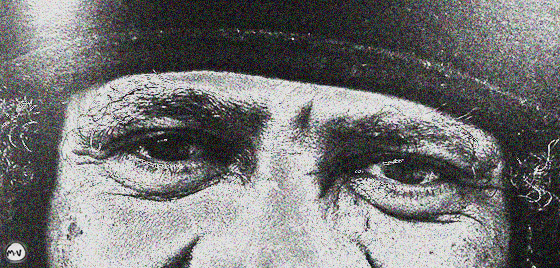
vergonha…
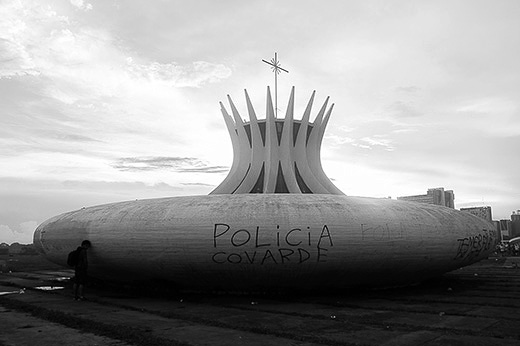
fotografia de pedro castro
sabe qual foi o artista que mais vendeu cd em 2016?

Giant ‘Mozart 225’ Box Set is 2016’s Biggest-Selling CD Release
The biggest-selling CD act of 2016 doesn’t sing. He doesn’t play guitar and he doesn’t tour. In fact, no one alive has ever seen him.
In a quirky result bound to appear as a question in pub quizzes for years to come, a massive boxed set of Wolfgang Amadeus Mozart’s recordings has emerged as the biggest-selling CD release of the year.
Mozart 225: The New Complete Edition has shifted 1.25 million total CDs in the five weeks since its Oct. 28 release, according to Universal Music Group. The collection is formidable in every sense. It comprises a whopping 200 CDs, presenting every work by the classical great; features the talents of 600 world-class soloists and 60 orchestras, and plays for a total of 240 hours (not to mention the many hours of additional reading materials bundled in). Crunch the numbers and that’s upwards of 6,250 sold box sets.
Universal unveiled the exhaustive project in late August after 18 months of curation and planning, with the music major declaring it the “most authoritative, complete and scholarly box set ever devoted to the work of a single composer.”
The release of Mozart 225 coincides with the 225th anniversary of the Classical-era genius’ death. “It is wonderful to see the reaction to this box set, which is the fruit of years of scholarship, planning and curation,” comments Paul Moseley, UMG’s director of Mozart 225. “Mozart’s immortal melodies, no less than The Beatles or Abba, are in some way part of all our lives – and this Edition is the perfect way to celebrate that on his 225th anniversary.”
Mozart 225 was produced by Decca and Deutsche Grammophon in collaboration with the Salzburg Mozarteum Foundation.
– enviado pela marcia e retirado DAQUI
social club…
reparou quem passou por aqui, ontem, na foto que o luiz mandou?
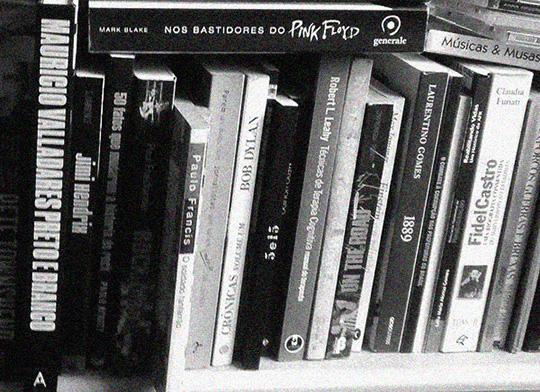
dessas coisas que acontecem no nosso poleiro.
geral…

Assunto: adeus, geral – Filme completo“Maurição, filme completo no youtube, canal oficial dos produtores, coisa linda
Não sei se já saiu no tico-tico, ou se já conhecia, mas acho que se encaixa na veia futebolistica .“Entendendo que o futebol é uma representação fiel de nossa realidade, surge o documentário “Adeus, Geral”, que teve seu início a partir de um trabalho escolar de Geografia sobre “muros sociais”. O filme busca explorar a elitização do futebol brasileiro, que exclui dos estádios as camadas mais pobres da população.
Produzido por 5 alunos do Ensino Médio, movidos pelo sentimento de expor as injustiças que esse muro social representa, deu voz a torcedores, jornalistas, técnicos e ex-jogadores para entender o que significa essa tendência.
Participam, com depoimentos, nomes como os jornalistas Juca Kfouri e Mauro Cezar Pereira, o ex-técnico do Corinthians, Tite, o presidente do Palmeiras, Paulo Nobre, o ex-jogador Alex e membros das principais torcidas organizadas de São Paulo.”
—
Tiago
reverberando o “preto e branco”, hoje…
em inoxidável matéria assinada por silvio essinger, o segundo caderno (o globo) abriu as porteiras para o “preto e branco”… basta clicar AQUI

super-terça rolando…
e o globoesporte.com jah começa o massacre do vernáculo:
Cahê Mota@CAHEMOTAMesmo antes de qualquer resultado hoje, ainda é quase impensável VÊ o Vasco sem o acesso. Cenário, porém, deve ser levado em conta #trcolina


